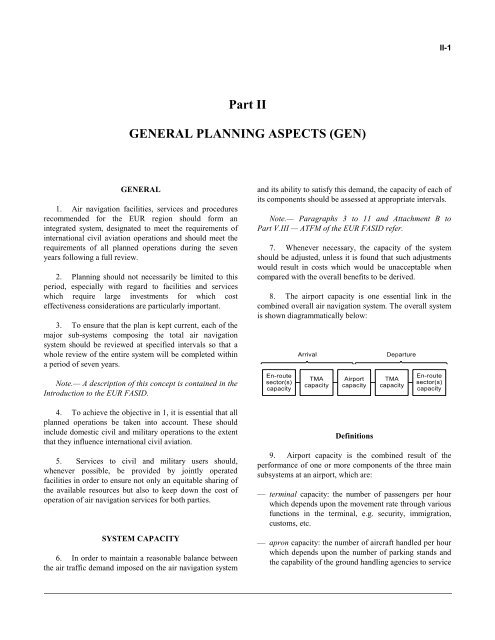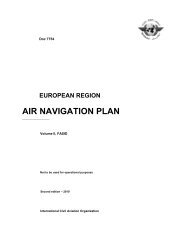7754 Vol 1 Flyleaf - ICAO Public Maps
7754 Vol 1 Flyleaf - ICAO Public Maps
7754 Vol 1 Flyleaf - ICAO Public Maps
You also want an ePaper? Increase the reach of your titles
YUMPU automatically turns print PDFs into web optimized ePapers that Google loves.
Part II<br />
GENERAL PLANNING ASPECTS (GEN)<br />
GENERAL<br />
1. Air navigation facilities, services and procedures<br />
recommended for the EUR region should form an<br />
integrated system, designated to meet the requirements of<br />
international civil aviation operations and should meet the<br />
requirements of all planned operations during the seven<br />
years following a full review.<br />
2. Planning should not necessarily be limited to this<br />
period, especially with regard to facilities and services<br />
which require large investments for which cost<br />
effectiveness considerations are particularly important.<br />
3. To ensure that the plan is kept current, each of the<br />
major sub-systems composing the total air navigation<br />
system should be reviewed at specified intervals so that a<br />
whole review of the entire system will be completed within<br />
a period of seven years.<br />
Note.— A description of this concept is contained in the<br />
Introduction to the EUR FASID.<br />
4. To achieve the objective in 1, it is essential that all<br />
planned operations be taken into account. These should<br />
include domestic civil and military operations to the extent<br />
that they influence international civil aviation.<br />
5. Services to civil and military users should,<br />
whenever possible, be provided by jointly operated<br />
facilities in order to ensure not only an equitable sharing of<br />
the available resources but also to keep down the cost of<br />
operation of air navigation services for both parties.<br />
SYSTEM CAPACITY<br />
6. In order to maintain a reasonable balance between<br />
the air traffic demand imposed on the air navigation system<br />
II-1<br />
and its ability to satisfy this demand, the capacity of each of<br />
its components should be assessed at appropriate intervals.<br />
Note.— Paragraphs 3 to 11 and Attachment B to<br />
Part V.III — ATFM of the EUR FASID refer.<br />
7. Whenever necessary, the capacity of the system<br />
should be adjusted, unless it is found that such adjustments<br />
would result in costs which would be unacceptable when<br />
compared with the overall benefits to be derived.<br />
8. The airport capacity is one essential link in the<br />
combined overall air navigation system. The overall system<br />
is shown diagrammatically below:<br />
Definitions<br />
9. Airport capacity is the combined result of the<br />
performance of one or more components of the three main<br />
subsystems at an airport, which are:<br />
— terminal capacity: the number of passengers per hour<br />
which depends upon the movement rate through various<br />
functions in the terminal, e.g. security, immigration,<br />
customs, etc.<br />
— apron capacity: the number of aircraft handled per hour<br />
which depends upon the number of parking stands and<br />
the capability of the ground handling agencies to service














